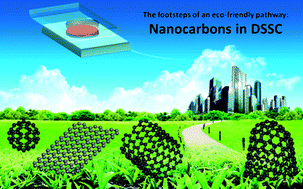Recent advances in multifunctional nanocarbons used in dye-sensitized solar cells†
Abstract
Throughout recent years the implementation of nanocarbons into dye-sensitized solar cells (DSSC) has resulted in important breakthroughs. The most relevant of them in this context are (i) the enhancement of charge transport and charge collection in nanocarbon-doped electrodes, (ii) the introduction of nanocarbon interlayers that simultaneously reduce the charge recombination and increase the charge collection efficiency, (iii) the use of nanocarbon-based, iodine-free, solid-state electrolytes featuring excellent diffusion coefficients and catalytic efficiencies, (iv) the use of novel nanocarbon-based hybrid dyes, and (v) the use of nanocarbons towards platinum-free counter electrodes. The first four aforementioned aspects are thoroughly described in this review.


 Please wait while we load your content...
Please wait while we load your content...